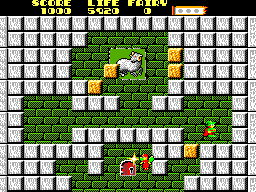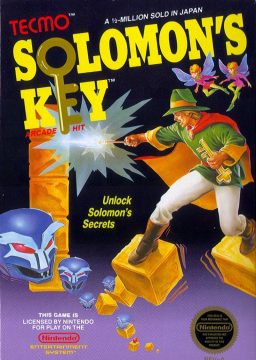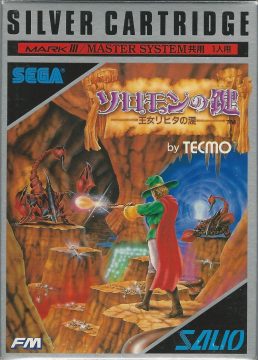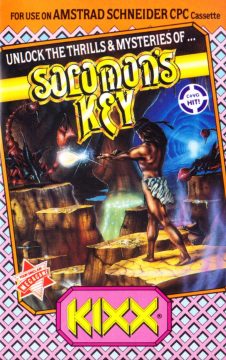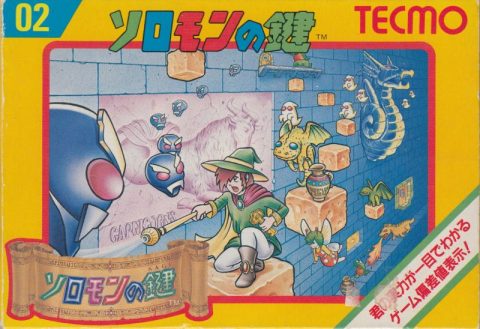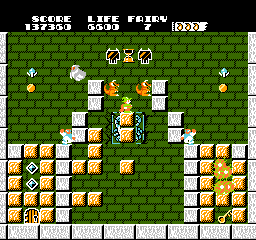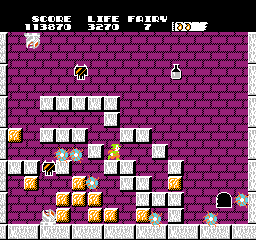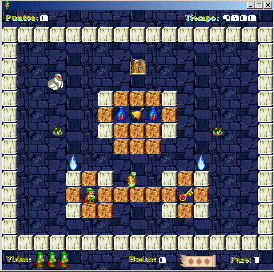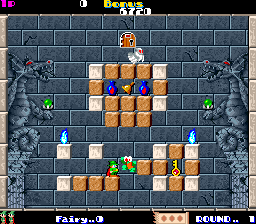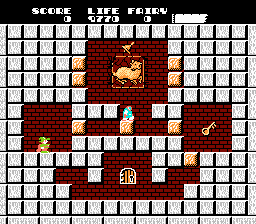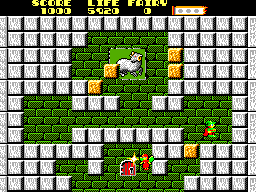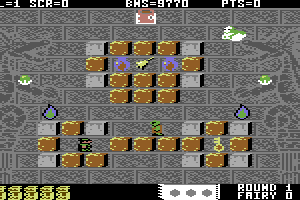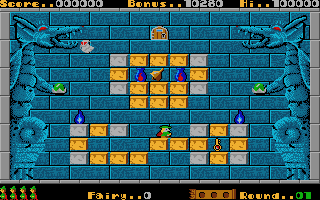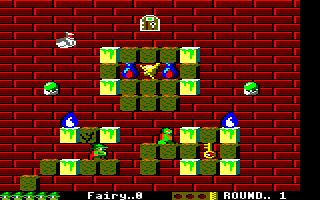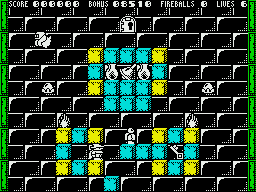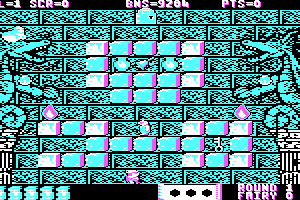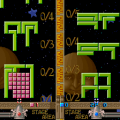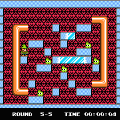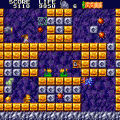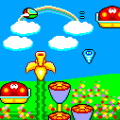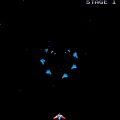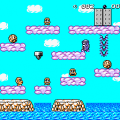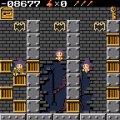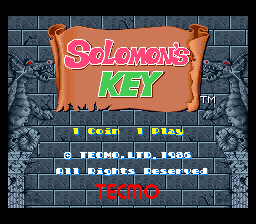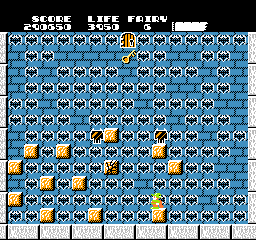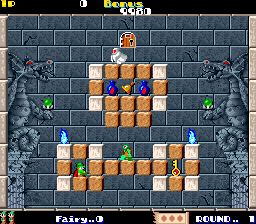For some reason Japanese retro gamers often fondly remember old arcade games that are nowadays seen as ridiculously difficult, frustrating and sadistic. Some examples are Namco’s The Tower of Druaga, Irem’s Spelunker and Solomon’s Key by Tecmo. The latter one managed to found an audience in the West too, and is admittedly less unfair, but that doesn’t make it any less devious.
The titular Key is a book made by King Solomon himself in order to keep evil spirits and demons under control and trap them in the so-called “Constellation Space”: of course someone goes and takes it, thus freeing all kinds of monsters and putting the world into chaos. Yutra, the ruler of the Lyrac fairy kingdom, then commands magician Dana to go to Constellation Space and retrieve the Key; the problem is that Dana is a dorky weakling whose only ability is to conjure blocks from nowhere and destroy them, either with his wand or by headbutting them from below a la Mario. He can also shoot mostly short-ranged fireballs, but only in a very limited quantity.
Solomon’s Key is a fantasy puzzle-platformer that first appeared in arcades in 1986, and later received many ports up to the present day. It consists of about fifty single-screen rooms where our hero has to create and destroy blocks in order to first reach a key and then the door that gets him out of the stage; the premise is basic, but the game is actually quite hard.
Not only several puzzles are brain teasers (at times some scenery elements are sadistically placed to make an apparently simple solution much more difficult) and putting the blocks in the wrong place can make them unwinnable, but one also has to have quick reflexes typical of arcade games as well: most stages have enemy generators that endlessly spawn monsters, and several of the enemies can not only destroy blocks in their way but also chase Dana down or “just” move randomly and unpredictably. So one also has little time to figure out how the levels work before getting in contact with baddies.
Dana himself dies at the slightest contact, can’t shield himself or become invincible, and has very few ways to counter or destroy the monsters (luckily, they disappear after a while if they are stuck and there are already several on the screen). On top of all that, being a coin-op, there’s also a time limit, and keep in mind that there’s no way of undoing wrong moves or resetting a stage outside of killing Dana! Also, you can’t buy victory with money since the coin-op’s setting doesn’t let you continue after stage 31. Have fun.
As a typical arcade game of the Eighties, there’s also a large amount of scoring opportunities, bonuses, secret items and hidden stuff. Most levels have bells in them that, if picked up, will call a fairy and make her appear from the stage’s door. Dana will get an extra life for every 10 fairies collected. Be careful, though, not to hit them with fireballs.
Destroying certain blocks or creating them into certain empty spaces, and then destroying them, can make some items appear, and some special ones net huge amounts of points… provided that you can manage to find them in each level they are hidden, or else they won’t appear for the rest of the game.
Most important, though, are the bonus stages and secret stages, the latter of which can be accessed by using the wand on certain keys, turning them into blue keys and taking Dana to an alternate route through the stage’s door.
The sprites are nice for the time period, with all the items, characters and enemies (ghosts, dragons, mages, etc.) being immediately recognizable even if made of only a few pixels. The arcade also has the funny detail of Dana’s eyes bugging out every time he hits a block with his head. The various background statues and decorations are nicely drawn as well. However, the puzzle game nature of the title makes the general graphics quite repetitive, with settings consisting mostly only of stone blocks and walls. The only touches that stand out are the symbols and representations of the Western zodiac signs, the central theme of the game, appearing on the backgrounds.
The arcade game received a big number of ports for several consoles and computers of the time, including the NES, Master System (Japan-only), Atari ST, Amstrad CPC, Commodore 64 and ZX Spectrum; it was then included in two compilations in the mid-2000s, Tecmo Hit Parade for PlayStation 2 (2004) and Tecmo Classic Arcade for XBOX (2005). The most well-known of all the game’s many ports is certainly Tecmo’s own NES cartridge, which was a fairly big success in the day and is probably the version most gamers are familiar with when speaking of Solomon’s Key. It is as good as the arcade, besides the obvious graphics and sound downgrade, still very hard, and also adds some new stuff in the mix.
For starters, the game now evaluates how well you’ve played with the so-called “Game Deviation Value” found at the game over screen: to this day, nobody is quite sure on how those numbers are calculated, though the higher the score, the better the game. However this screen is better remembered for the cheat code that can be inputted there, the only way to continue the game. By holding A, B, and Up at the G.D.V. screen the game will restart from the last level reached; however, since the game wasn’t being nasty enough, you can’t use it to continue from level 41 on.
Another difference from the arcade is that the hidden bonus rooms are no longer accessed by using the wand on the keys, but by finding the zodiac tiles hidden every four levels, thus bringing the total of secret bonus rooms from 7 to 12. There are also the eight super-secret Solomon Seals which, if found and picked up (easier said than done, since if you miss even one no more will appear!), will open the rooms where the two missing pages of Solomon’s Key are hidden; those then will make the fairy princess appear in a final room at the end, all this in order to get the real and best ending.
There are also some new bonuses not present in the arcade, namely golden wings that make you warp to later levels and… Bomb Jack! Tecmo’s “superhero” is hidden in two levels and can only be found by headbutting a certain block 11 times. Talk about obscure stuff.
The NES port would be released on every Nintendo online store, starting with the Wii’s Virtual Console in 2006, the 3DS and WiiU Virtual Consoles in 2012-13, and then on the Switch Online as part of the Classic Game Selections library in October 2018.
The ports for Western personal computers were published by US Gold in 1987 and all handled by Probe. The most faithful one is the 16-bit Atari ST port, then the Amstrad one which however is kind of slow, and the C64 one is good too, with a nice new melody during the intro. The one for MS-DOS is terrible though, with its 4-color graphics, chunky indistinct sprites and grating beeper music. The ZX Spectrum one has no music (but sound effects are there), acceptable speed and downgraded but still serviceable graphics, with some limitations like missing visual effects and the huge dragon statues absent from the first stage’s background (that however happens to the Amstrad port too). A bit of trivia: the illustration on the covers for some reason replaces Dana with some Conan-esque barbarian dude.
About the Master System/Mark III cartridge, it was a regional exclusive published by Salio, a third-party company which was actually a dummy company made by Tecmo, and received the subtitle Ojou Rihita no Namida (王女リヒタの涙 ) meaning “Princess Rihita’s Tears”. It is very similar to the NES version but it suffers from a slight lag in the jumps, and in a game that requires precision like this one, this could potentially be a big flaw.
There exist two modern computer remakes/conversions as well. A freeware one was made for Windows by Spanish utility developer Zikitrake Software, probably in the early 2000s. It features a MIDI piano rendition of the main theme and some very cheesy sound effects, but for the rest is quite faithful to the original arcade. It can be found here: http://www.edukate.es/solomons-key-remake/
The second is an Amiga conversion which is actually from 2013: coders Asman and Wanted Team reverse-engineered the Atari ST release and thus managed to give Commodore’s other personal computer yet another port. Some info can be found on the Amiga Board forum here: http://eab.abime.net/showthread.php?t=68861
Screenshot Comparisons
